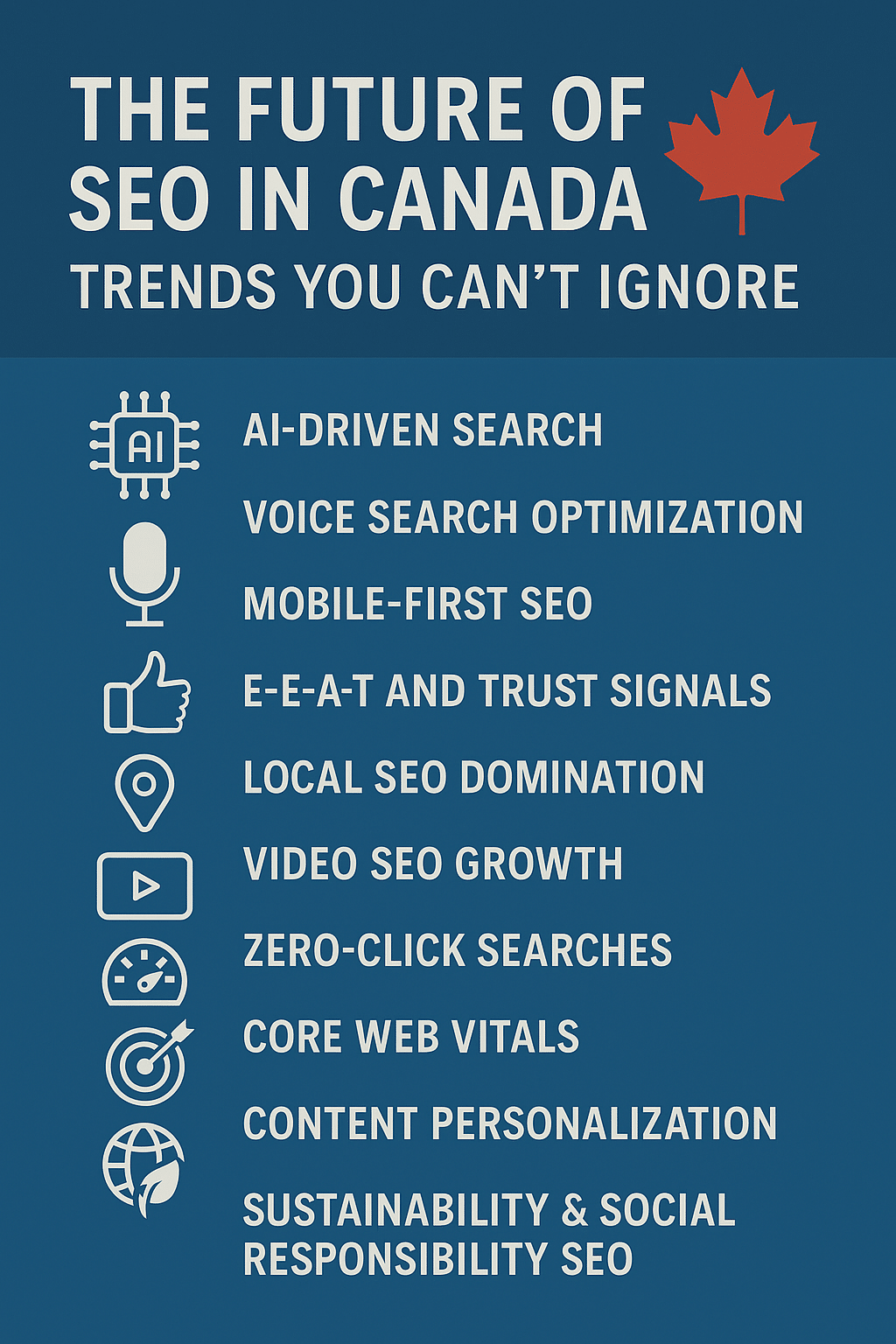The world of Search Engine Optimization (SEO) never stands still — and in Canada, it’s moving faster than ever. Google’s AI-driven updates, the rise of voice search, and changes in user behavior are reshaping how businesses appear online.
If you own a business in Toronto, Vancouver, Calgary, or anywhere across Canada, understanding where SEO is heading is crucial. Whether you’re a small local shop or a nationwide brand, adapting to the future of SEO in Canada could mean the difference between dominating search results or disappearing from them entirely.
In this deep dive, we’ll explore the top trends Canadian businesses can’t ignore in 2025 and beyond — and how you can use them to get ahead of your competition.
Why SEO Matters More Than Ever in Canada
You might be wondering: “Is SEO still worth it in 2025?” The answer is a resounding yes — but the way we do it is changing.
Canada’s Online Consumer Behavior
91% of Canadians use Google to research products or services before buying
Local searches like “near me” have grown by 150% in the last 3 years
Mobile searches now account for over 65% of all traffic in Canada
This means your customers are out there, searching — but you have to adapt to new algorithms and search habits to be found.
Trend #1: AI-Driven Search is Reshaping SEO
With Google’s Search Generative Experience (SGE) and AI-powered snippets, the way information is presented is evolving.
What It Means for Canadian Businesses
Expect fewer traditional blue links on page one
Google will provide AI-written answers that summarize information from multiple sites
To get visibility, your content needs to be cited by AI search results
Pro Tip: Create original, in-depth, expert-level content that AI can trust and reference.

Trend #2: Voice Search Optimization
With smart speakers like Google Nest and Amazon Echo, plus voice assistants on mobile, Canadians are increasingly using voice queries.
Why It Matters
Voice searches are:
Conversational (“Where’s the best pizza near me?”)
Long-tail (more specific)
Often location-based
How to Prepare:
Use FAQ-style content to match natural speech
Ensure your Google Business Profile is optimized for local results
Trend #3: Mobile-First SEO
Google now indexes mobile versions of websites first, meaning if your mobile site isn’t fast, responsive, and easy to navigate, you’re losing rankings.
Checklist for Mobile SEO in Canada:
Use a responsive design
Compress images without losing quality
Test speed with PageSpeed Insights
Make buttons and forms touch-friendly
Trend #4: E-E-A-T and Trust Signals
Google’s E-E-A-T framework — Experience, Expertise, Authoritativeness, and Trustworthiness — is more important than ever.
What You Should Do:
Include author bios on blog posts
Showcase case studies and testimonials
Get featured in Canadian news outlets and industry blogs
Secure quality backlinks from reputable Canadian websites
Trend #5: Local SEO Domination
For Canadian small businesses, Local SEO is a goldmine.
Key Tactics:
Optimize your Google Business Profile with regular updates and photos
Collect and respond to Google reviews
Add local schema markup so Google understands your location and service area
Create location-specific landing pages (e.g., “Plumbing Services Toronto,” “Plumbing Services Mississauga”)
Trend #6: Video SEO Growth
Canadians consume a massive amount of video content — and Google is showing more video results in search.
How to Rank Videos:
Upload to YouTube with keyword-rich titles and descriptions
Embed videos on your site to boost dwell time
Add captions and transcripts for accessibility and indexing
Trend #7: Zero-Click Searches
Google now answers many queries directly in the search results, meaning users don’t always click through to websites.
How to Still Get Traffic:
Target featured snippets
Use structured data for FAQ, reviews, and products
Answer user questions quickly and clearly in your content
Trend #8: Core Web Vitals
Google’s Core Web Vitals measure the speed, responsiveness, and stability of your site.
Key Metrics:
LCP (Largest Contentful Paint) – Page load speed
FID (First Input Delay) – How quickly your site responds to clicks
CLS (Cumulative Layout Shift) – Visual stability
Tools: Use GTmetrix and Lighthouse to test and improve these scores.
Trend #9: Content Personalization
Personalized content based on user behavior and location is becoming more common in Canada.
Examples:
Showing different offers to Toronto vs. Vancouver visitors
Recommending services based on past browsing
Using geo-targeted blog posts
Trend #10: Sustainability & Social Responsibility SEO
Canadian consumers care about sustainability. Google is beginning to show preference for brands that align with eco-friendly values.
Ways to Showcase This:
Create content about your green initiatives
Get listed in sustainable business directories
Partner with eco-conscious Canadian influencers
How Canadian Businesses Can Prepare
To adapt to these trends:
Audit your site for mobile, speed, and Core Web Vitals
Update your content strategy for AI, voice, and video
Double down on Local SEO
Build authority and trust signals
Stay ahead by testing and tracking with Google Search Console and Analytics
Conclusion: The SEO Future is Here — Don’t Get Left Behind
The future of SEO in Canada is exciting but challenging. With AI reshaping search, voice search growing, and local competition heating up, the winners will be those who adapt early.
If you want to stay ahead of your competitors, start implementing these trends now — because in the SEO world, early movers get the rankings.
Whether you’re a local coffee shop in Ottawa, a law firm in Vancouver, or an e-commerce brand selling Canada-wide, these trends can help you dominate google’s search engine ranks.


